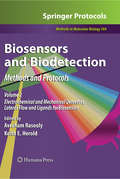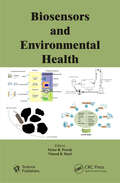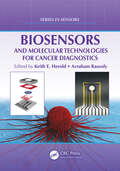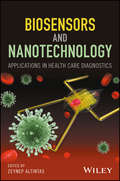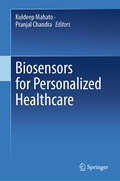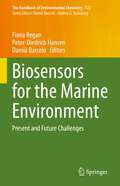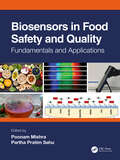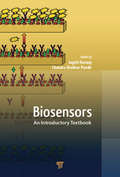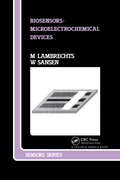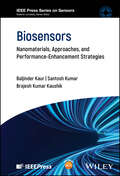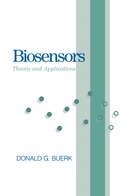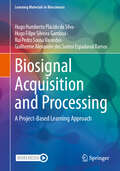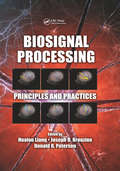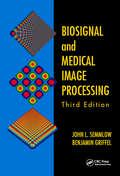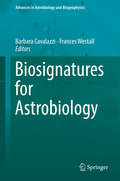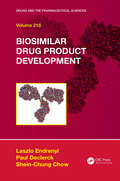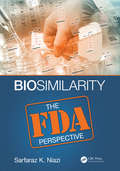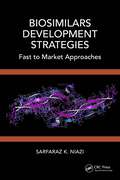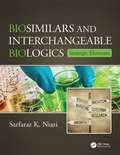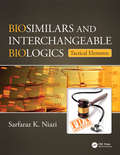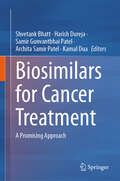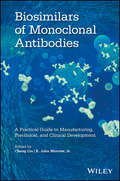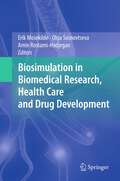- Table View
- List View
Biosensors and Biodetection - Methods and Protocols Volume 2: Methods and Protocols Volume 2: Electrochemical and Mechanical Detectors, Lateral Flow and Ligands for Biosensors (Methods in Molecular Biology #504)
by Keith Herold Avraham RasoolyBiosensors combine biological recognition elements and signal conversion elements into a biodetection system. They have been developed for a wide variety of biodetection applications, offering the advantages of increased speed and ease of use compared to traditional detection methods. In Biosensors and Biodetection: Methods and Protocols, leading experts describe the major technologies in the field in extensive technical detail, allowing readers both to understand the technology and to construct similar devices. Volume 2: Electrochemical and Mechanical Detectors, Lateral Flow and Ligands for Biosensors focuses on direct measurement sensors, indirect methods, ligands, and related technologies, including methods involving electrochemical detectors, recognition ligands, antibodies, aptamers, and peptides, amongst many other subjects. Written in the highly successful Methods in Molecular Biology™ series format, chapters include brief introductions to the topics, lists of the necessary materials, step-by-step, readily reproducible protocols, and Notes sections, which highlight tips on troubleshooting and avoiding known pitfalls.<P><P> Comprehensive and up-to-date, Biosensors and Biodetection: Methods and Protocols is an ideal, user-friendly guide to this vital, versatile technology and a perfect tool for those who wish to further the field.
Biosensors and Environmental Health
by Victor R. Preedy Vinood B. PatelDiscussing the role biosensors play in detecting and monitoring environmental substances, Biosensors and Environmental Health provides key facts that can be applied to other areas of health and disease and a "mini-dictionary" of key terms and summary points. It covers personal toxicity testing, soil and risk assessment, pesticide, insecticides, par
Biosensors and Invasive Monitoring in Clinical Applications (SpringerBriefs in Applied Sciences and Technology)
by Martyn G. Boutelle Emma P. CórcolesThis volume examines the advances of invasive monitoring by means of biosensors and microdialysis. Physical and physiological parameters are commonly monitored in clinical settings using invasive techniques due to their positive outcome in patients' diagnosis and treatment. Biochemical parameters, however, still rely on off-line measurements and require large pieces of equipment. Biosensing and sampling devices present excellent capabilities for their use in continuous monitoring of patients' biochemical parameters. However, certain issues remain to be solved in order to ensure a more widespread use of these techniques in today's medical practices.
Biosensors and Molecular Technologies for Cancer Diagnostics (Series in Sensors)
by Avraham Rasooly Keith E. HeroldBridging the gap between research and clinical application, Biosensors and Molecular Technologies for Cancer Diagnostics explores the use of biosensors as effective alternatives to the current standard methods in cancer diagnosis and detection. It describes the major aspects involved in detecting and diagnosing cancer as well as the basic elements
Biosensors and Nanotechnology: Applications in Health Care Diagnostics
by Zeynep AltintasProvides a broad range of information from basic principles to advanced applications of biosensors and nanomaterials in health care diagnostics This book utilizes a multidisciplinary approach to provide a wide range of information on biosensors and the impact of nanotechnology on the development of biosensors for health care. It offers a solid background on biosensors, recognition receptors, biomarkers, and disease diagnostics. An overview of biosensor-based health care applications is addressed. Nanomaterial applications in biosensors and diagnostics are included, covering the application of nanoparticles, magnetic nanomaterials, quantum dots, carbon nanotubes, graphene, and molecularly imprinted nanostructures. The topic of organ-specific health care systems utilizing biosensors is also incorporated to provide deep insight into the very recent advances in disease diagnostics. Biosensors and Nanotechnology: Applications in Health Care Diagnostics is comprised of 15 chapters that are presented in four sections and written by 33 researchers who are actively working in Germany, the United Kingdom, Italy, Turkey, Denmark, Finland, Romania, Malaysia and Brazil. It covers biomarkers in healthcare; microfluidics in medical diagnostics; SPR-based biosensor techniques; piezoelectric-based biosensor technologies; MEMS-based cell counting methods; lab-on-chip platforms; optical applications for cancer cases; and more. Discusses the latest technology and advances in the field of biosensors and their applications for healthcare diagnostics Particular focus on biosensors for cancer Summarizes research of the last 30 years, relating it to state-of-the-art technologies Biosensors and Nanotechnology: Applications in Health Care Diagnostics is an excellent book for researchers, scientists, regulators, consultants, and engineers in the field, as well as for graduate students studying the subject.
Biosensors for Personalized Healthcare
by Pranjal Chandra Kuldeep MahatoThis book covers the basic principles and advanced methods used in the advancement of bioelectronics for therapeutic purposes. This book provides a thorough examination of the development and progress in bioelectronics devices and biosensors, emphasizing current improvements in individualized diagnostics using biosensing modules, tools, and approaches. It offers useful insights into the creation of biosensors for individualized healthcare diagnostics by analyzing the underlying principles of sensing methods. This book primarily emphasizes the incorporation of biosensing technologies into wearable, implantable, and biomedical devices. These advancements are transforming healthcare by enabling uninterrupted monitoring and immediate data gathering, ultimately improving patient care. The book also highlights the significance of downsizing biosensor platforms, demonstrating approaches that enhance the compactness and efficiency of these devices while maintaining their performance. The book also discusses point-of-care devices, which are of great importance. These devices are essential in clinical laboratories and care units, such as ICUs and ambulatory settings, since they provide fast, precise, and immediate diagnostic capabilities. The book showcases the most recent breakthroughs in personalized diagnostics via the use of biosensing-based bioelectronics devices, highlighting its capacity to revolutionize the provision of healthcare. This book examines the real-world uses of biosensor technology in customized healthcare throughout various chapters. It explores the customization of these devices to cater to the specific requirements of each patient, enabling accurate and prompt medical treatments. This book is a valuable resource for academics, practitioners, and enthusiasts in the subject of bioelectronics and healthcare. It combines in-depth scientific discussions with practical real-world applications. In essence, this book serves as a foundation for comprehending the profound influence of biosensor technology on personalized health care. This book encourages readers to investigate the promising opportunities that await in the field of bioelectronics, where groundbreaking devices and methods are poised to revolutionize medical diagnostics and patient treatment.
Biosensors for the Marine Environment: Present and Future Challenges (The Handbook of Environmental Chemistry #122)
by Damià Barceló Fiona Regan Peter-Diedrich HansenThis book is devoted to the exploration of innovative sensing technologies for marine applications. The book focuses on various novel biosensor designs from nano-biosensors to molecularly imprinted polymers offering a broad perspective for marine biosensors development to deployment challenges.The book aims to target researchers in the area of marine monitoring, sensor developments and deployment of devices in the marine environment.
Biosensors in Food Safety and Quality: Fundamentals and Applications
by Partha Pratim Sahu Poonam MishraBiosensors in food safety and quality have become indispensable in today’s world due to the requirement of food safety and security for human health and nutrition. This book covers various types of sensors and biosensors that can be used for food safety and food quality monitoring, but these are not limited to conventional sensors, such as temperature sensors, optical sensors, electrochemical sensors, calorimetric sensors, and pH sensors. The chapters are framed in a way that readers can experience the novel fabrication procedures of some advanced sensors, including lab-on-a-chip biosensors, IoT-based sensors, microcontroller-based sensors, and so on, particularly for fruits and vegetables, fermented products, plantation products, dairy-based products, heavy metal analysis in water, meat, fish, etc. Its simplistic presentation and pedagogical writing provide the necessary thrust and adequate information for beginners, scientists, and researchers. The book offers comprehensive coverage of the most essential topics, which include the following: Fundamentals of biosensors Overview of food safety and quality analysis Major toxicants of food and water Fabrication techniques of biosensors applicable for different segments of the food industry This book serves as a reference for scientific investigators who work on the assurance of food safety and security using biosensing principles as well as researchers developing biosensors for food analysis. It may also be used as a textbook for graduate-level courses in bioelectronics.
Biosensors: An Introductory Textbook
by Jagriti Narang C. S. PundirNanotechnology is a budding field and has a pivotal role in sensing. Nanomaterials exist in various forms such as nanoparticles, nanoclusters, nanobelts, and nanospheres. These nanomaterials act as sensing interfaces and immobilization surfaces for various biomolecules such as enzymes, DNA, and antigens. Therefore, the preparation and characterization of these nanoparticles play an important role in sensing devices. This handbook has evolved from the authors’ teaching and research experience in the field of nanoparticle biosensing. It encompasses protocols for the synthesis of various forms of metal oxide nanoparticles; study of the various characterizing techniques that help deduce the shape, size, and morphology of these nanoparticles; and applications of these nanoparticles in the field of biosensors. It presents voltammetry techniques such as cyclic, linear wave, wave pulse, and differential pulse voltammetry, throws light on the interactions of nanomaterials and biomolecules, and discusses microfluidic devices, which due to their unique capability of miniaturization fascinate many researchers. It is a practical and user-friendly textbook that introduces the various basic principles and practical information that will help undergraduate and advanced-level students and researchers understand the science behind nanoscale sensing.
Biosensors: Fundamentals, Emerging Technologies, and Applications (Emerging Materials and Technologies)
by Sibel A. Ozkan Bengi Uslu Mustafa Kemal SezgintürkBiosensors: Fundamentals, Emerging Technologies, and Applications provides insight into the sensing applications of different types of biosensors relating to environmental pollutants, microbiological analysis, and healthcare. It describes state-of-the-art research in biosensors, point of care testing, potential applications, as well as future prospects for biosensors. This book: Presents the essentials that readers need to know to make full use of biosensor technology Discusses recent perspectives on optical and electrochemical biosensors Details biosensor types for medical applications Teaches how to use enzymes for biological recognition in biomarker assays Proposes innovations in wearable and smart biosensors This book is aimed at advanced students, researchers, and academics across a broad interdisciplinary field including biochemical, pharmaceutical, and environmental engineering as well as materials science, analytical chemistry, and biosciences.
Biosensors: Microelectrochemical Devices
by M Lambrechts W SansenBiosensors are analytical devices that combine a biologically sensitive element with a physical or chemical transducer to selectively and quantitatively detect the presence of specific compounds. Balancing basics, principles, and case studies, Biosensors: Microelectrochemical Devices covers the theory and applications of one class of biosensor-microelectrochemical devices. The book clearly explains microelectronic techniques used to produce these cheap, fast reacting, and disposable sensors with the aid of helpful diagrams and tables. Researchers and postgraduates active in the field of chemical sensors, analytical chemistry, or microelectronics will find this an invaluable reference.
Biosensors: Nanomaterials, Approaches, and Performance-Enhancement Strategies (IEEE Press Series on Sensors)
by Brajesh Kumar Kaushik Santosh Kumar Baljinder KaurComprehensive resource covering new technologies, materials, strategies, and recent advancements in the field of biosensing Biosensors summarizes cutting-edge technologies in biosensing, including gene editing (known as Clustered Regularly Interspaced Short Palindromic Repeat or CRISPR), quorum sensing utilizing inter and intra cell signals, two-dimensional (2D) materials and aptamer-mediated sensor designs, and more, with additional coverage of the latest materials, strategies, and advancements made in the field. Chapters are categorized on the basis of various bio-recognition elements that include aptamer, nucleic acid, enzymes, antibodies, bacteriophages, peptides, and molecular imprinted polymers. Plasmonic, surface-enhanced Raman scattering, colorimetric, fluorescence, electrochemical, magneto and piezo-electric biosensor sensing techniques are also considered. The roles of various nanomaterials, advancement in synthesis, signal enhancement strategies, and new trends for biomedical applications are also described. Current challenges, limitations, and future prospects to developing biosensors for point-of-care and clinical applications are also discussed. Written by three highly qualified authors, Biosensors includes information on: Diverse bio-receptors include nucleic acids, aptamers, enzymes, antibodies, bacteriophages, molecularly imprinted polymers, whole-cell, and techniques of immobilization Different transduction principles using bio-receptors (e.g., optical, electrochemical, piezo-electrical, and SERS) to detect microorganism, toxins, and diseases Nanomaterials synthesis, their role in biosensing, pros and cons of carbon, polymer, metals, metal oxides, and quantum dots-based nanomaterials in medical biosensing applications Biosensors is a comprehensive and complete resource on the subject for researchers and professionals in physics, chemistry, and biomedical science, research communities working in the fields of plasmonics, optics, biosensors, and nano-photonics, and students in related programs of study.
Biosensors: Theory and Applications
by Donald G. BuerkThis introductory text covers in detail the technology and applications of biosensors in their many forms. It provides an extensive survey of the basic principles, functions and applications of different categories of biosensors. The presentation is concise, systematic and well illustrated. Numerous schematics illustrate design and function.This bo
Biosignal Acquisition and Processing: A Project-Based Learning Approach (Learning Materials in Biosciences)
by Hugo Humberto da Silva Hugo Filipe Silveira Gamboa Rui Pedro Sousa Varandas Guilherme Alexandre dos Santos Espadanal RamosThis textbook provides an introduction to common concepts in biosignal acquisition and processing, rooted in a Project-Based Learning (PBL). A series of exercises and corresponding solutions is described, with a focus on common problems that new entrants encounter in the undergraduate and graduate curriculums in biomedical engineering, psychophysiology, human-computer interaction, physiotherapy, and others developing work in the boundary between biosignal acquisition and other disciplines. Solutions include both hardware and software components, encompassing sensor design, biosignals acquisition using the Arduino and BITalino platforms, Python for signal processing, analysis, and knowledge extraction, including also HTML/CSS/JavaScript for user interface design. All the content is supported with rich graphics, source code, and other useful resources made available to the interested reader. This is an ideal book for undergraduate students and practitioners (across disciplines) who are studying or working in the field of biomedical signal acquisition, processing, and analysis.
Biosignal Processing: Principles and Practices
by Joseph D. Bronzino Donald R. Peterson Hualou LiangWith the rise of advanced computerized data collection systems, monitoring devices, and instrumentation technologies, large and complex datasets accrue as an inevitable part of biomedical enterprise. The availability of these massive amounts of data offers unprecedented opportunities to advance our understanding of underlying biological and physiol
Biosignal and Medical Image Processing
by John L. Semmlow Benjamin GriffelWritten specifically for biomedical engineers, Biosignal and Medical Image Processing, Third Edition provides a complete set of signal and image processing tools, including diagnostic decision-making tools, and classification methods. Thoroughly revised and updated, it supplies important new material on nonlinear methods for describing and classify
Biosignatures for Astrobiology (Advances in Astrobiology and Biogeophysics)
by Barbara Cavalazzi Frances WestallThis book aims at providing a brief but broad overview of biosignatures. The topics addressed range from prebiotic signatures in extraterrestrial materials to the signatures characterising extant life as well as fossilised life, biosignatures related to space, and space flight instrumentation to detect biosignatures either in situ or from orbit. The book ends with philosophical reflections on the implications of life elsewhere. In the 15 chapters written by an interdisciplinary team of experts, it provides both detailed explanations on the nature of biosignatures as well as useful case studies showing how they are used and identified in ancient rocks, for example. One case study addresses the controversial finding of traces of fossil life in a meteorite from Mars. The book will be of interest not only to astrobiologists but also to terrestrial paleontologists as well as any reader interested in the prospects of finding a second example of life on another planet.
Biosimilar Drug Product Development (Drugs and the Pharmaceutical Sciences)
by Shein-Chung Chow Laszlo Endrenyi Paul Jules DeclerckWhen a biological drug patent expires, alternative biosimilar products are developed. The development of biosimilar products is complicated and involves numerous considerations and steps. The assessment of biosimilarity and interchangeability is also complicated and difficult. Biosimilar Drug Product Development presents current issues for the development of biosimilars and gives detailed reviews of its various stages and contributing factors as well as relevant regulatory pathways and pre- and post-approval issues.
Biosimilarity: The FDA Perspective
by Sarfaraz NiaziSummary: The focus of this book is on how the U.S. FDA will approve biosimilar drugs, as learned from recent approvals by the FDA. Understanding the limitations of the statutory limits and non-inferiority testing are presented as tools to obviate patient trials and minimize testing of immunogenicity. An in-depth scientific, mathematical and statistical view of the tools required to establish biosimilarity of biological drugs of different complexity -- a must for every developer of biosimilars. Features: First comprehensive analysis based on new guidelines and approval packages of several biosimilars Presents the first approach to challenge FDA in reducing or eliminating any testing in patients. Provides a comprehensive understanding of the U.S. statutory requirements vis-a-vis the regulatory guidelines Provides model CQA and Analytical Similarity testing protocols for cytokines and monoclonal antibodies Allow creation of a fast-to-market pathway to develop biosimilars
Biosimilars Development Strategies: Fast to Market Approaches
by Sarfaraz K. NiaziAfter 18 years since the first biosimilar was approved, a lot has changed, from the regulatory guidelines to the stakeholder perceptions about the safety and efficacy of biosimilars. However, the development costs remain high, preventing faster entry into markets with more than 200 choices. Analyzing the regulatory filings of all approved biosimilars in the US and EU, a deep analysis of the scientific principles, and continuous challenges to the regulatory authorities have made it possible to plan the development on a fast track. This book teaches how to cut the current time and cost by more than 70%, based on the author's hands-on experience.Features: Describes the emergence of biosimilars since the first publication of the recombinant engineering patent, as well as a listing of all approved recombinant products, their patent expiry and their adoption across the globe. Provides a better understanding of the safety and efficacy of approved biosimilars. Global approval requires accommodating guidelines and detailed planning to avoid redundancy as well as high costs. The basic expectations of the agencies are presented here. Presents a detailed analysis of all EU and FDA-approved products with a comparative analysis. Renowned author and entrepreneur in the field of drug discovery and production.
Biosimilars and Interchangeable Biologics: Strategic Elements
by Sarfaraz NiaziWhat’s the Deal with Biosimilars? Biosimilars are gaining momentum as new protein therapeutic candidates that can help fill a vital need in the healthcare industry. The biological drugs are produced by recombinant DNA technology that allows for large-scale production and an overall reduction time in costs and development. Part of a two-volume set that covers varying aspects of biosimilars, Biosimilars and Interchangeable Biologics: Strategic Elements explores the strategic planning side of biosimilar drugs and targets issues surrounding biosimilars that are linked to legal matters. This includes principal patents and intellectual property, regulatory pathways, and concerns about affordability on a global scale. It addresses the complexity of biosimilar products, and it discusses the utilization of biosimilars and related biological drugs in expanding world markets. Of specific interest to practitioners, researchers, and scientists in the biopharmaceutical industry, this volume examines the science, technology, finance, legality, ethics, and politics of biosimilar drugs. It considers strategic planning elements that include an overall understanding of the history and the current status of the art and science of biosimilars, and it provides detailed descriptions of the legal, regulatory, and commercial characteristics. The book also presents a global strategy on how to build, take to market, and manage the next generation of biosimilars throughout their life cycle.
Biosimilars and Interchangeable Biologics: Tactical Elements
by Sarfaraz K. NiaziWhat's the Deal with Biosimilars?Biosimilars are gaining momentum as new protein therapeutic candidates that can help fill a vital need in the healthcare industry. The biological drugs are produced by recombinant DNA technology that allows for large-scale production and an overall reduction time in costs and development. Part of a two-volume set th
Biosimilars for Cancer Treatment: A Promising Approach
by Kamal Dua Shvetank Bhatt Harish Dureja Samir Gunvantbhai Patel Archita Samir PatelThe book delves into the role of biosimilars in the field of cancer treatment. It also discusses the application of biosimilars in various cancer types, from colorectal and cervical to prostate, gastric, lung, pancreatic, breast, hepatocellular, ovarian, and blood cancers. It contains chapters that focus on the clinical trials of biosimilars, providing insights into the latest research and developments. This book serves as a valuable resource for clinicians, researchers, and anyone seeking a comprehensive understanding of the intersection between biosimilars and cancer treatment.
Biosimilars of Monoclonal Antibodies: A Practical Guide to Manufacturing, Preclinical, and Clinical Development
by Cheng Liu K. John Morrow Jr.Addressing a significant need by describing the science and process involved to develop biosimilars of monoclonal antibody (mAb) drugs, this book covers all aspects of biosimilar development: preclinical, clinical, regulatory, manufacturing. • Guides readers through the complex landscape involved with developing biosimilar versions of monoclonal antibody (mAb) drugs• Features flow charts, tables, and figures that clearly illustrate processes and makes the book comprehensible and accessible• Includes a review of FDA-approved mAb drugs as a quick reference to facts and useful information• Examines new technologies and strategies for improving biosimilar mAbs
Biosimulation in Biomedical Research, Health Care and Drug Development
by Olga Sosnovtseva Amin Rostami-Hodjegan Erik MosekildeBiosimulation is an approach to biomedical research and the treatment of patients in which computer modeling goes hand in hand with experimental and clinical work. Constructed models are used to interpret experimental results and to accumulate information from experiment to experiment. This book explains the concepts used in the modeling of biological phenomena and goes on to present a series of well-documented models of the regulation of various genetic, cellular and physiological processes. The way how the use of computer models allows optimization of cancer treatment for individual patients is discussed and models of interacting nerve cells that can be used to design new treatments for patients with Parkinson's disease are explained. Furthermore this volume provides an overview on the use of models in industry, and presents the view of regulatory agencies on the topic.
